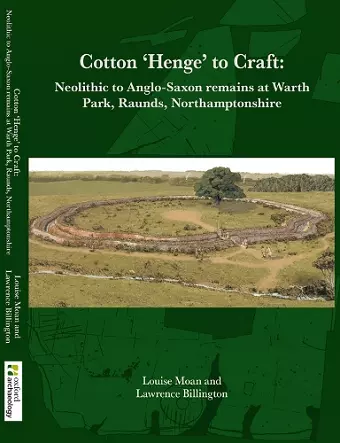Cotton ‘Henge’ to Craft
Neolithic to Anglo-Saxon Remains at Warth Park, Raunds, Northamptonshire
Lawrence Billington author Louise Moan author
Format:Paperback
Publisher:Oxford Archaeology East
Published:31st Aug '24
Should be back in stock very soon

Between 2013 and 2018, the construction of a new industrial park afforded Oxford Archaeology the opportunity to investigate 19ha of land on the western edge of Raunds, Northamptonshire. The archaeological works revealed evidence for human activity spanning the early Neolithic to middle Saxon periods. From at least the early 18th century, the area has been under cultivation and has conse-quently suffered the effects of a substantial period of ploughing. Key to the development of the site was an early Neolithic monumental ditched enclosure, recorded in the Northamptonshire Historic Environment Record (NHER) as Cotton ‘Henge’. Its excavation provided important new evidence for its date and its influence on the surrounding landscape. Nearby lay middle and late Neolithic pits containing pottery and struck flint. Positioned at the centre of the ‘Henge’ was an early Bronze Age barrow, which was subsequently incorporated into a Middle Bronze Age field system. Dense settlement remains dating to the early to middle Iron Age transition extended across much of the site, including structures, numerous storage pits or silos, cobbled trackways and a pit alignment. Large assemblages of pottery, animal bone and other finds came from these features, alongside rich environmental remains. Romano-British activity was significant, with non-settlement, craft and agrarian-related remains extending across the area. Features included a pottery kiln and corn dryer, various burials and six stone-lined wells. The latter yielded important finds and environmental assemblages, preserved in their waterlogged fills. The most impressive item was a near life-sized carved wooden arm, believed to be a votive offering. This is an extremely rare find and perhaps the only item of its type from Roman Britain. Anglo-Saxon settlement took the form of numerous sunken-featured buildings. By the post-medieval period, the development site lay beneath strip fields associated with the village of Raunds to the east; by this time, the adjacent medieval village of Mallows Cotton (located to the immediate west) had been abandoned. The archaeological evidence uncovered at Warth Park has demonstrated that this area has been a widely exploited and managed landscape for approximately five millennia. The remains reflect an agricultural site, with associated craft and funerary activity, linked to known settlement areas in the wider environs.
ISBN: 9781907588167
Dimensions: unknown
Weight: unknown
288 pages